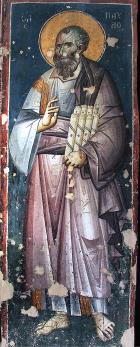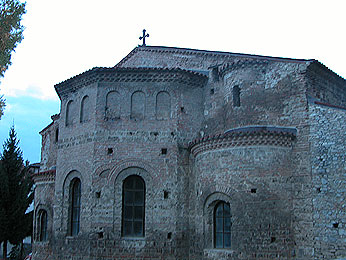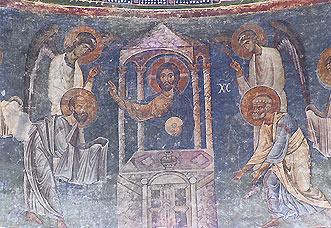Enclosure of the letter
(
14.06.2005
)
A HISTORICAL SUMMARY OF THE
 The Macedonian Orthodox Church (MOC), the legitimate successor of the Ohrid Archbishopric (OA), has its beginnings in the Apostolic times, from the second and the third journey of Holy Apostle Paul with his co–journers through Macedonia, when the first Christian communities on Balkan and European soil were established (Acts 16:9-12, Romans 15:19 and 2 Cor. 8:1).
The Macedonian Orthodox Church (MOC), the legitimate successor of the Ohrid Archbishopric (OA), has its beginnings in the Apostolic times, from the second and the third journey of Holy Apostle Paul with his co–journers through Macedonia, when the first Christian communities on Balkan and European soil were established (Acts 16:9-12, Romans 15:19 and 2 Cor. 8:1).
The spiritual life on the territory of the Republic of Macedonia, has been developed during early Christian times, which is witnessed by the participation of the local bishops at the Ecumenical and local Councils (the Holy Bishop Achil of Larisa and Prespa at the First Ecumenical Council in 325 AD; bishop Evagriy of Heraclea Lincestis at the Council of Sardica in 343-344 AD; Quintilius at the Council of Ephesus in 449 AD, and at the Fourth Ecumenical Council, while Benignus of Heraclea was at the Council of Constantinople in 533 AD, and others).
An autocephalous Church existed on this territory of ours even in 6th century AD under the name of Iustiniana Prima, established by the most reknown Church and state jurist the Holy Emperor Iustinian, with its see in Iustiniana, today`s Skopje.
After the diminishing of Iustiniana Prima after approximately three centuries, there was a great re–evangelisation and spiritual renewal in 893 AD, with the organisation of the Church by the most talented student of the Holy brothers Cyril and Methodius – St. Clement, bishop of Velika. The Diocese of St. Clement has been the basis for the establishing of the Ohrid Archbishopric as an autocephalous Church, starting from the times of Samuel`s empire (997–1018), until its abolishment in 1767.
The prestige of the Ohrid Archbishopric, the Heads of which have signed as Archbishops of Iustiniana Prima, was huge, so neither the Byzantine emperor Basil II, after defeating Samoil`s state in 1018, nor the Serbian tsar Dushan the Strong, after conquering Macedonia in 14th century, have not abolished it, but allowed the Ohrid Archbishopric to exist in their empires too, as an autocephalous Church parallel with the Constantinople and the Pec Patriarchate respectively. It has even re–established its jurisdiction over the dioceses of the Pec Patriarchate after the fall of Smederevo under the rule of the Otoman empire in 1449 AD, until the renewal in 1557 AD, and that happened after its non–canonical separation from the Ohrid Archbishopric in 1219 AD, under the heading of St. Sava Nemanjic.
The Otoman Porta has decided that only one
It was, in fact, a time when the autonomous and sovereign states and Orthodox peoples in the Balkans have proclaimed or renewed autocephalous Churches (the Greek, the Serbian, the Bulgarian, and the
After World War I, the
At the beginning of World War II, the Serbian Prelates and the Serbian priesthood have abandoned
During the period of 1919-1922, the dioceses in today's  ars!
ars!
The renewal of the Ohrid archbishopric as Macedonian Orthodox Church has begun as soon as the first liberated territories on Macedonian soil were established, with the first Clergy Council in Izdeglavje near Ohrid on 20 October 1043, and on 5 and 6 March 1943 at the First Clergy–Laity Council in Skopje, which has been attended by over 300 delegates, priests and laity, and that has brought a Decision for "Renewal of the Ohrid archbishopric as Macedonian Orthodox Church".
Since the Orthodox Church in the People's Republic of
That's when the Constitution of the Macedonian Orthodox Church as an autonomous Church was adopted.
The Archbishop's Council of the Serbian Orthodox Church, with Decision No. 06/1959, has recognised the autonomy (SELF-DEPENDENCE) of the renewed Ohrid Archbishopric, i. e. the Macedonian Orthodox Church. It was agreed that the unity between the Serbian Orthodox Church and the Macedonian Orthodox Church should be expressed by a personal union of the Serbian Patriarch, who was to sign as Patriarch of Serbia and
But, soon after that, the Serbian Orthodox Church started revising its Decision for the Autonomy (SELF-DEPENDENCE) of the Macedonian Orthodox Church, and therefore the Macedonian Orthodox Church has insisted that the Serbian Orthodox Church should present it in front of the other Local Orthodox Churches, but the SOC has constantly refused that and denied the SELF–DEPENDENCE of the Macedonian Orthodox Church with the annulment of the personal union. Therefore, the Macedonian Orthodox Church has asked for an autocephaly from the Serbian Orthodox Church, in order to resolve the misunderstandings. The Serbian Orthodox Church has denied autocephaly to the Macedonian Orthodox Church, and that's when the Macedonian Orthodox Church was forced to officially declare the renewed autocephaly of the Ohrid Archbishopric by itself, convening an Archbishop's Clergy–Laity Council in 1967, similar to the way certain Orthodox Churches were renewed or declared (from the renewed autocephaly of the Pec Archbishopric – the Serbian Orthodox Church, and the Trnovo Patriarchate – the Bulgarian Orthodox Church, etc), including the latest example of accepting of the autocephaly of the Albanian Orthodox Church by the other Orthodox Churches.
It is worth to note that granting autocephaly to a Church is a very inconsistent issue in the teaching and the understading of the Orthodox Church, although it is very important. Namely, some ancient Churches that have lost their high clergy and the mother state, after the renewal of the state or the high clergy, have been granted autocephaly, while from others, like from the Macedonian Orthodox Church, it is demanded that they should pass through the process of autonomy. The Macedonian Orthodox Church, although it is a renewed ancient Church, even 60 years after its renewal, the autocephaly is being denied, although, according to the 17th Rule of the Fourth Ecumenical Council and the 38th Rule of the Sixth Ecumenical Council, we have a canonical and historic right to autocephaly, since we are an ancient Church, and we have a sovereign country.
There is also an inconsistency in the Orthodoxy on the issue of who is authorised to grant autocephaly: the Mother Church or the Ecumenical Patriarchate – so there are cases that some Churches are being granted autocephaly twice, e.g. the Polish and the Chechoslovakian Church, while there are cases when some Churches are being granted autocephaly from their Mother Church, like the American Orthodox Church, while other Churches (mostly the Greek Churches) do not recognise that , although they serve together with their prelates.
The Macedonian Orthodox Church, has insisted on establishing a dialogue with the Serbian Orthodox Church many times from 1967 to 1991, but it has always been refused. During this period, there have been only two meetings on a Commissions' level: in the St. Prohor Pcinjski Monastery in 1978, and in the St. Bogorodica Monastery in Kalishte by Struga in 1979, but without success. The main subject on these meetings was the issue of competency – who grants autocephaly. The Serbian Orthodox Church Commission thought that the right to grant autocephaly "belongs to the Ecumenical Patriarchate or to the future Ecumenical Council", contrary to its former opinion that "it is a competency of the Mother Church". So, the Serbian Orthodox Church has always acted upon this issue according to its current interests and circumstances.
Because of this stand of the Serbian Orthodox Church, a delegation of the Macedonian Orthodox Church has visited the Patriarch of Constantinople kyr Bartholomeus on  etween the Serbian and the
etween the Serbian and the
On 15 and 16 April 1992, there was a meeting between the Commissions of the Serbian and the Macedonian Orthodox Churches in the St. Bogorodica Monastery in Kalishta, Republic of Macedonia, and by the proposal of His High Reverency Metropolitan of Zagreb and Ljubljana kyr Jovan – the President of the Commission of the Serbian Orthodox Church – a common stance was adopted that an Eucharistic union should be established between the prelates and the clergy of the Serbian and the Macedonian Orthodox Churches, and that the issue of autocephaly should be resolved by a dialogue.
The Synod of the Macedonian Orthodox Church has accepted this stance, while the Archbishop's Council of the Serbian Orthodox Church has rejected it and immediately brought contrary decisions to this – making the first step to usurp the jurisdiction of the Macedonian Orthodox Church in the Republic of Macedonia, appointing an administrator for the so called Serbian Dioceses in the Republic of Macedonia. The most probable reason for this was the collapse of all Serbian plans for a confederation between
Then, the Serbian Orthodox Church forced a proposed agreement for the resolution of this issue, which has been further refined at every meeting of the Commissions. But when the Macedonian Orthodox Church proposed its own document in Nis, on 17 May 2002, similar to the one offered by the Serbian Orthodox Church, the Commission of the SOC rejected it, and abusing the confidence of the members of the Commission of the MOC, planted a working document from two meetings earlier – so the Commission of the Macedonian Orthodox Church insisted on the signing of the working document from Nis. The signing of the working proposal–document from
The Archbishop's Council of the Serbian Orthodox Church has accepted this document, but has forged its most sensitive part – the Constitutional name of the Republic of Macedonia – which was changed into Former Yugoslav Republic of Macedonia (see Nis Document from 17 May 2002 and the Decision of the Holy Bishop's Synod of the Serbian Orthodox Church No. 38/2002). That way, the Serbian Orthodox Church has shown that its intention is to abuse the Macedonian Orthodox Church, which consists of the majority of the population in the Republic of Macedonia (67%), to influence the change of the Constitutional name of the Republic of Macedonia, and with it, the name of the Macedonian Orthodox Church, the language, the culture and all the particularities of the Macedonian people.
The Serbian Orthodox Church, in order to implement its intentions, and to help the change of the Constitutional name of the Macedonian nation and Church, has found an ally in the person of the former Metropolitan of Povardarie Jovan, who was elected and ordained in the Macedonian Orthodox Church, and was later defrocked because of proven canonical offences, and for whom the Serbian bishop Pachomius said, in an interview for a local television: "We have looked for a man like that a long time".
Urged by pride, love of power and money, the apostate former prelate completely took the side of the Serbian Orthodox Church, denying the name of his own country, the Republic of Macedonia, and the Macedonian Orthodox Church, and renouncing his origin, put himself in the service of nationalistic propagandas aimed against the Macedonian Orthodox Church and the Republic of Macedonia, for which he was completely supported by the Serbian Orthodox Church.
The Serbian Orthodox Church, after accepting him, found two more candidates originating out of the clergy of the Macedonian Orthodox Church to non-canonically elect and ordain, and established a Serbian Exarchate with them, which is in fact a virtual (they don't have people around them) alleged autonomous Serbian Church in the Republic of Macedonia, naming it an Orthodox Ohrid Archbishopric (OOA), abusing the name of our ancient Ohrid Archbishopr ic.
ic.
At the last meeting of the Archbishop's Council of the Serbian Orthodox Church, in May 2005, the Serbian Orthodox Church granted the so called OOA a Decision for an alleged autonomous Church and expanded its decision against the Macedonian Orthodox Church from 1967 for Eucharistic exclusion of the bishops and the clergy of the Macedonian Orthodox Church with the Orthodox people in the Republic of Macedonia if it stays in communion with the Macedonian Orthodox Church:
This act of the Serbian Orthodox Church caused bitterness not only with the Macedonian people and the other Orthodox faithful, but with all the citizens of Republic of Macedonia, even with the Serbian Orthodox people in Serbia and Montenegro.
So, the Serbian Orthodox Church, which has one-sidedly and with malicious intention, not showing even basic signs of evangelical love towards the Macedonian Orthodox Church, cut off the Eucharistic communion with the bishops, clergy, and the monkhood earlier, now, with its last decision, had cut off its communion with the whole of the Orthodox people in the Macedonian Orthodox Church. Therefore, the Macedonian Orthodox Church prayerfully asks You and Your Holy Church to show Your evangelical love towards our people and Church of God, who live according to the teachings of the Holy Orthodox Church, the Holy Scripture and the Holy Tradition for almost 2000 years.
We beseech you to accept the Macedonian Orthodox Church as your most humble sister in Christ, our Lord, the Head of the Orthodox Church.
You should also be aware that, being in this condition, after this pressure from the Serbian Orthodox Church, our people is exposed to further pressures from different cults, while some Macedonian intellectuals even speak of resolving this issue through various Unions.
In case you need more information, we are ready to provide them to you in common discussion, wherever it suits you best.
Your Holiness, if we don't receive signs of evangelical love from You and Your Holy Church, and because of this non-sincere attitude of the Serbian Orthodox Church, towards our Holy Church and our Orthodox people, rest assured that the sin against the Macedonian Orthodox Church will be on the conscience of the whole of Orthodoxy.
Your brother in Christ our Lord and in prayers,
HEAD
OF THE HOLY BISHOP'S SYNOD
OF THE MACEDONIAN ORTHODOX CHURCH
ARCHBISHOP OF OHRID AND MACEDONIA
† S T E F A N